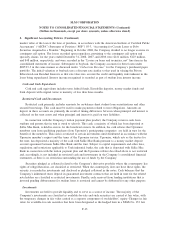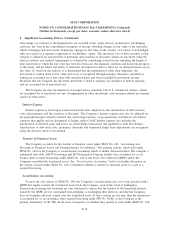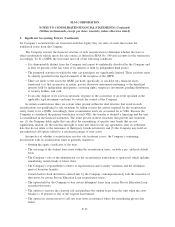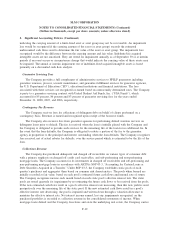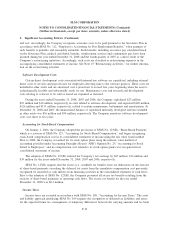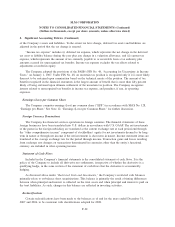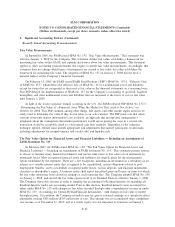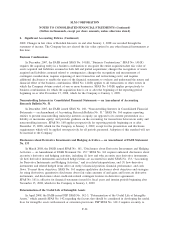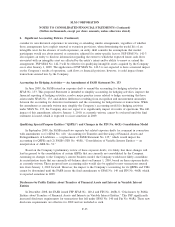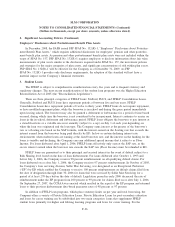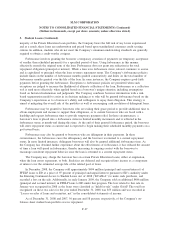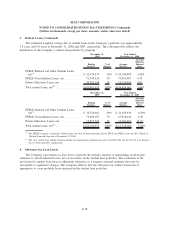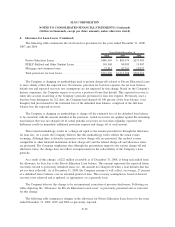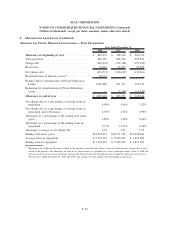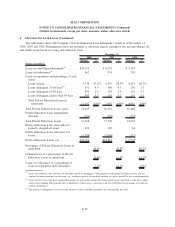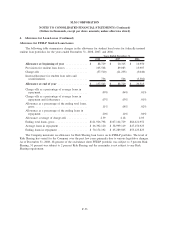Sallie Mae 2008 Annual Report Download - page 143
Download and view the complete annual report
Please find page 143 of the 2008 Sallie Mae annual report below. You can navigate through the pages in the report by either clicking on the pages listed below, or by using the keyword search tool below to find specific information within the annual report.2. Significant Accounting Policies (Continued)
Recently Issued Accounting Pronouncements
Fair Value Measurements
In September 2006, the FASB issued SFAS No. 157, “Fair Value Measurements.” This statement was
effective January 1, 2008 for the Company. This statement defines fair value, establishes a framework for
measuring fair value within GAAP, and expands disclosures about fair value measurements. This statement
applies to other accounting pronouncements that require or permit fair value measurements. Accordingly, this
statement does not change which types of instruments are carried at fair value, but rather establishes the
framework for measuring fair value. The adoption of SFAS No. 157 on January 1, 2008 did not have a
material impact on the Company’s financial statements.
On February 12, 2008, the FASB issued FASB Staff Position (“FSP”) SFAS No. 157-2, “Effective Date
of SFAS No. 157,” which defers the effective date of SFAS No. 157 for nonfinancial assets and liabilities,
except for items that are recognized or disclosed at fair value in the financial statements on a recurring basis.
This FSP delayed the implementation of SFAS No. 157 for the Company’s accounting of goodwill, acquired
intangibles, and other nonfinancial assets and liabilities that are measured at the lower of cost or fair value
until January 1, 2009.
In light of the recent economic turmoil occurring in the U.S., the FASB released FSP SFAS No. 157-3,
“Determining the Fair Value of a Financial Asset When the Market for That Asset is Not Active,” on
October 10, 2008. This FSP clarified, among other things, that quotes and other market inputs need not be
solely used to determine fair value if they do not relate to an active market. The FSP points out that when
relevant observable market information is not available, an approach that incorporates management’s
judgments about the assumptions that market participants would use in pricing the asset in a current sale
transaction would be acceptable (such as a discounted cash flow analysis). Regardless of the valuation
technique applied, entities must include appropriate risk adjustments that market participants would make,
including adjustments for nonperformance risk (credit risk) and liquidity risk.
The Fair Value Option for Financial Assets and Financial Liabilities — Including an Amendment of
FASB Statement No. 115
In February 2007, the FASB issued SFAS No. 159, “The Fair Value Option for Financial Assets and
Financial Liabilities — Including an Amendment of FASB Statement No. 115.” This statement permits entities
to choose to measure many financial instruments and certain other items at fair value (on an instrument by
instrument basis). Most recognized financial assets and liabilities are eligible items for the measurement
option established by the statement. There are a few exceptions, including an investment in a subsidiary or an
interest in a variable interest entity that is required to be consolidated, certain obligations related to post-
employment benefits, assets or liabilities recognized under leases, various deposits, and financial instruments
classified as shareholder’s equity. A business entity shall report unrealized gains and losses on items for which
the fair value option has been elected in earnings at each reporting date. The Company adopted SFAS No. 159
on January 1, 2008, and elected the fair value option on all of its Residual Interests effective January 1, 2008.
The Company chose this election in order to simplify the accounting for Residual Interests by including all
Residual Interests under one accounting model. Prior to this election, Residual Interests were accounted for
either under SFAS No. 115 with changes in fair value recorded through other comprehensive income or under
SFAS No. 155, “Accounting for Certain Hybrid Financial Instruments,” with changes in fair value recorded
through income. At transition, the Company recorded a pre-tax gain to retained earnings as a cumulative-effect
adjustment totaling $301 million ($195 million net of tax). This amount was in accumulated other comprehen-
sive income as of December 31, 2007, and as a result, equity was not impacted at transition on January 1,
F-23
SLM CORPORATION
NOTES TO CONSOLIDATED FINANCIAL STATEMENTS (Continued)
(Dollars in thousands, except per share amounts, unless otherwise stated)


